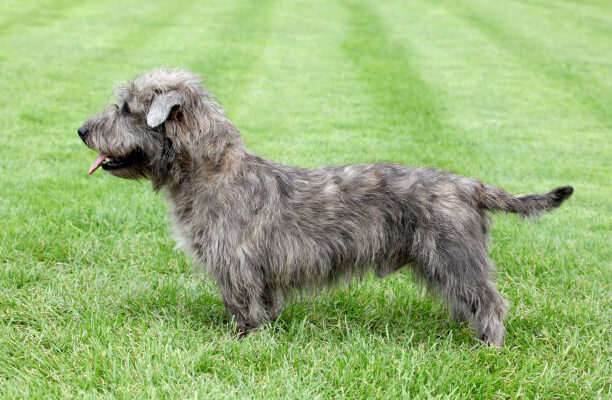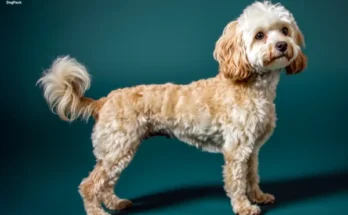A Glen of Imaal Terrier boasts massive devotion while preserving its small physique. The Wicklow Mountains of Ireland gave birth to this exclusive terrier type, demonstrating its powerful working abilities and strong bonds with humans. A complete reference document details all critical elements about Glen of Imaal Terriers, including their historical background alongside their physical traits and maintenance requirements, and personality characteristics.
Table of Contents
- Introduction to Glen of Imaal Terriers
- History and Origin
- Physical Characteristics
- Personality and Temperament
- Training a Glen of Imaal Terrier
- Exercise and Activity Needs
- Nutritional Requirements and Diet
- Grooming and Hygiene
- Common Health Issues and Preventive Care
- Socialization and Behavior
- Living Conditions and Adaptability
- Fun Activities and Games
- Conclusion
Introduction to Glen of Imaal Terriers
The Glen of Imaal Terrier characterizes itself through its sturdy body structure plus its dedication to work, and its intensely loving nature. The Glen exists as a functional farm dog with vermin hunting heritage because it displays remarkable devotion to its people. Despite their small size, Glen of Imaal Terriers display both their tough and low-slung body type, together with strong physical capabilities. Glen Terriers possess a steady temperament because they function equally well during outdoor excursions,s well as having a preference for relaxed indoor activities.
History and Origin
Roots in the Wicklow Mountains
For centuries, settlers inhabiting the isolated valleys of County Wicklow in Ireland bred Glen of Imaal Terriers for their ability to aid farming and eliminate pests and execute spit meat turning duties.
Breed Development
Through centuries of existence, the Glens retained their original working-dog characteristics, which other showbred terriers lost. Their thick frame, together with short stature and strong hindquarters, enabled them to excel as hunters below ground and navigators over rough terrain.
Fun Fact:
Glen of Imaal Terriers performed the task of meat spit rotation during the early ages by following a treadmill inside the kitchen to ensure consistent fire roasting.
Physical Characteristics
Size and Build
- Height: Approximately 12.5–14 inches at the shoulder
- Weight: 32–40 pounds
- Build: Low-slung, muscular, and heavily boned
Glen Terriers are deceptively strong for their size. Their distinctive bowed legs give them a unique stance and immense pushing power.
Coat and Colors
The Glen’s weatherproof coat needs manual stripping to stay in good condition because it remains medium-length with a rough texture.
Recognized Colors:
- Wheat (ranging from cream to golden-red)
- Blue
- Blue Brindle
Their dense coat helps protect them in rough climates while giving them their signature rustic appearance.
Personality and Temperament

What Are Glen of Imaal Terriers Like?
Glen of Imaal Terriers remain relaxed as they interact with people by nature, when other terrier breeds tend to be high-spirited. A combination of courage and independence defines them, while loving relationships serve as their trademark quality with family members. Workers from their past lives show determination, sometimes leading to stubbornness, though they remain reserved when not provoked to aggressive behavior.
Are Glen of Imaal Terriers Good Family Dogs?
Absolutely. Glen Terriers demonstrate profound devotion to their families as well as all their family members including children. Glen Terriers create meaningful connections with their owners, along with displaying a character of peaceable behavior. Children need proper supervision when Glen Terriers are around because of their robust structure and active personality.
Are Glen Terriers Good Guard Dogs?
Yes. Glens maintain their alertness but do not attack strangers because they are naturally calm dogs. The combination of their strong, deep voice and courageous spirit enables them to be outstanding watchdogs.
Training a Glen of Imaal Terrier
Intelligence and Trainability
Glen Terriers possess smart intelligence; however, their independent behavior requires supervision. Treats alongside praise and toys function most effectively for training purposes. All punishment methods will result in defensive behaviors from the dog.
Basic Training Tips:
The first step in Glen Terrier training should be to enroll them in puppy classes.
Conduct pleasant periods of learning that remain both direct and engaging for brief durations.
Focus on consistency and patience.
Give rewards to dogs only when they display peaceful actions instead of granting them through reactive behavior.
The foundation of early owner-dog contact must rest on trust.
Socialization
The Glen needs early socialization to transform into an adjusted, mature adult. Different environmental contacts with multiple people, along with various sounds and animal interactions, allow them to become confident instead of fearful.
Exercise and Activity Needs
Daily Exercise Requirements
A daily exercise routine is vital for Glen Terrier health and well-being because these dogs show limited signs of hyperactivity. The optimal amount of physical exercise for Glen Terriers lies between 45 minutes and one hour each day.
Examples:
- Brisk walks
- Backyard play sessions
- Controlled off-leash runs in fenced areas
- Light agility exercises
Mental Stimulation
Glen Terriers display intellectual qualities, so mental stimulation is vital to stopping destructive conduct that emerges from boredom.
Ideas for Mental Engagement:
- Interactive puzzle toys
- Hide-and-seek games
- Trick training sessions
- Scent games and nose work activities
Nutritional Requirements and Diet
Recommended Diet
Protein-rich and high-quality dietary foods create support for Glen’s muscle development alongside their energy reserves and help maintain healthy coat condition.
Ideal Foods:
- Lean meats like chicken, turkey, and beef
- Salmon and fish for Omega-3s
- Vegetables like spinach, sweet potato, and carrots
- Fruits like blueberries for antioxidants
Feeding Schedule
- Puppies: 3–4 small meals per day
- Adults: 2 balanced meals per day
Monitor food portions carefully, as Glen Terriers are prone to weight gain if overfed. Always ensure access to clean, fresh water.
Grooming and Hygiene
Grooming Routine
Proper grooming of the Glen’s coat is essential to achieve and preserve both its rustic yet attractive appearance, together with optimal health status.
Grooming Essentials:
- Brushing: 2–3 times a week
- Hand-Stripping: Every 6–8 weeks (or professional grooming)
- Bathing: Once every 6–8 weeks or as needed
- Nail Trimming: Every 2–3 weeks
- Ear Cleaning: Weekly to prevent infections
- Teeth Brushing: 2–3 times per week for dental health
Coat Maintenance by Type
- Harsh coat texture repels dirt naturally.
- Avoid clipping the coat short, as it will soften the texture.
- Hand-stripping maintains the correct terrier look and coat quality.
Common Health Issues and Preventive Care
Common Health Conditions
Glens demonstrate excellent health abilities, yet they possess certain disease susceptibilities:
- Hip Dysplasia: Abnormal formation of the hip socket
- Progressive Retinal Atrophy (PRA): A Degenerative eye condition
- Hypothyroidism: Low thyroid function
- Allergies: Skin or environmental sensitivities
Preventive Care
- Schedule annual vet checkups
- Keep vaccinations up to date
- Maintain flea, tick, and heartworm prevention
- Monitor joints and eyes for early signs of issues
- Keep their weight under control to avoid joint strain
Socialization and Behavior
Tips for Socializing Your Glen Terrier
- Expose your Glen to diverse environments early.
- Arrange positive playdates with other dogs.
- Introduce friendly strangers regularly.
- Reward confident, non-reactive behavior.
- Attend puppy training or socialization classes.
Common Behavioral Traits
- Calm: Especially when compared to other terriers
- Brave: Willing to confront much larger animals if necessary
- Devoted: Extremely attached to their human family
- Quiet Workers: Tend to be less yappy than many terrier breeds
- Independent: Can be stubborn at times
Living Conditions and Adaptability
Best Living Environments
Glens thrive in all types of homes provided their basic requirements receive adequate attention.
Suitable Homes:
Houses with fenced yards
Active apartments with frequent outdoor outings
The spacious environment in rural regions provides perfect conditions for exploration
This breed is inappropriate for households that cannot continue their routine of daily exercises, together with mental activities.
Climate Sensitivity
- Cold Weather: Their thick coat offers some protection, but very cold climates may still require a jacket.
- Hot Weather: Ensure shade and water are readily available. Avoid long activities during peak heat.
Fun Activities and Games
Physical and Mental Games
To get the most enjoyment from their games, Glen Terriers enjoy using both their physical strength together with their mental abilities.
Game Ideas:
- Fetch: Good for burning energy
- Tug-of-War: Satisfies their strong jaws and bonding instinct
- Scent Work: Hide treats or toys around the house or yard
- Agility Courses: Simple backyard setups are excellent
Enrichment Tools
- Snuffle mats for mental stimulation
- Kong-style treat dispensers
- Puzzle toys
- Rotating new toys to maintain interest
Conclusion
The Glen of Imaal Terrier brings together delightful, loving companionship along with heroic work capabilities with its steady nature. Such terriers match up well with families or active households as long as the terriers receive love from their caregivers and receive daily mental and physical stimulation. The Glen Terrier reaches peak health through appropriate training, together with exercise and grooming, to establish itself as an essential member of your household.
Key Takeaways:
Glen Terriers possess natural traits of power with softness and self-directing intelligence, along with a necessity for routine social contacts.
They enjoy constant happiness from both regular moderate workouts plus psychological stimulation activities.
A Glen Terrier requires essential early training and grooming practices for their health needs.
Glen Terriers accept various environmental conditions yet achieve their best health with owners who actively participate.
It is impossible to find a more devoted or charming best friend than the Glen of Imaal Terrier when you love and care for them in an environment filled with enjoyable experiences.




